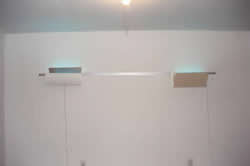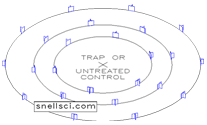Flying Insect Testing
- Snell Sci has presented our method for field testing mosquito traps at the American Mosquito Control Association’s national conference. Our method is a cost effective and highly sensitive (i.e able to measure small difference between trap models). The core value to our method is that we spent the time and effort to test hundreds of locations in order to find a series of balanced points on which to mount traps. We know that the use of 4 identical traps in 4 of our locations will provide less than 10% difference between trap counts. Other companies try to use only rotation to hope that can account for the imbalance of their locations, or large cages.
- We also have methods to help substantiate acreage coverage claims of mosquito traps. Our method using dozens of large malaise traps around the trap and replicated at several sites.
- For quick comparisons of trap models, we have large indoor cages. This provides repeatable conditions in order to set a ‘base line’ for each trap model. We use a pre-set number of female mosquitoes for each test so you don’t need to keep running repeat tests comparing to industry standard models. We set base lines for you of the traps you want and then help you compare small changes to your trap models. This provides a sensitive test that can be done year around and help you with comparisons and marketing data.
- Snell Sci has 2 matching release rooms that are specifically designed for flying insect testing with fly light traps, mosquito traps, attract-n-kill devices, lures and other flying insect products.
- We have a 12’x20′ building designed as a wind tunnel in order to test devices that need air flow such as the house fly z-9 tricosene (which doesn’t blume to allow attraction without some air flow) or other pheromones.


